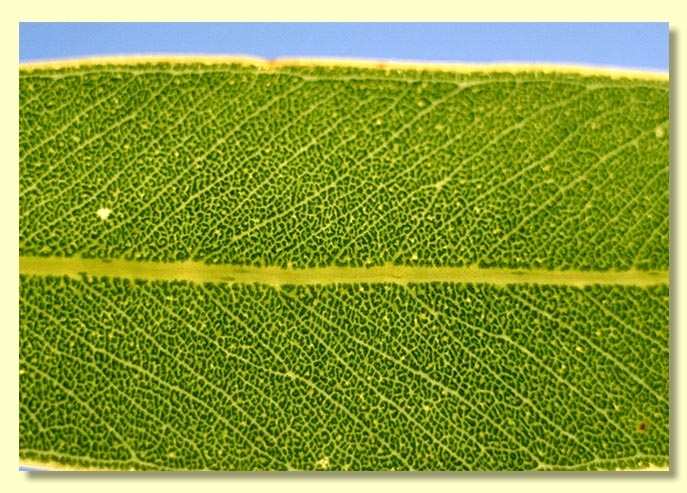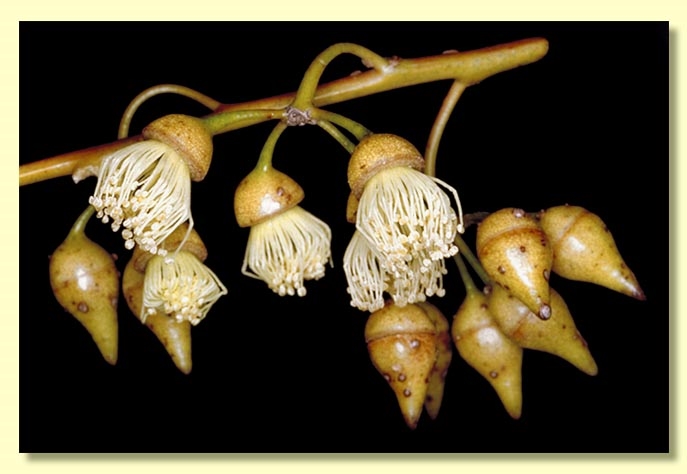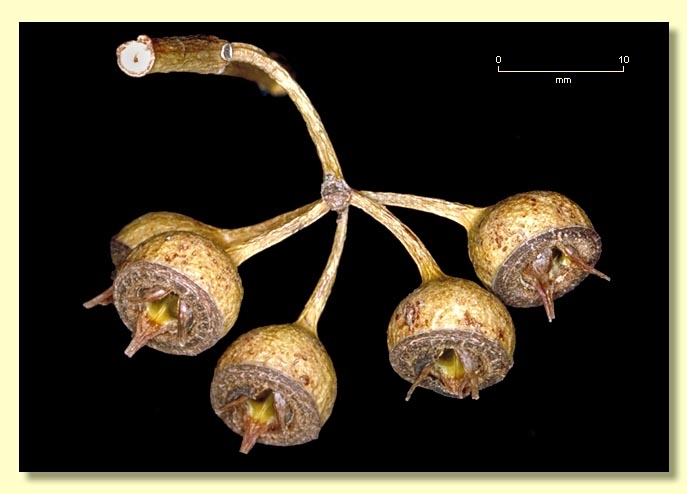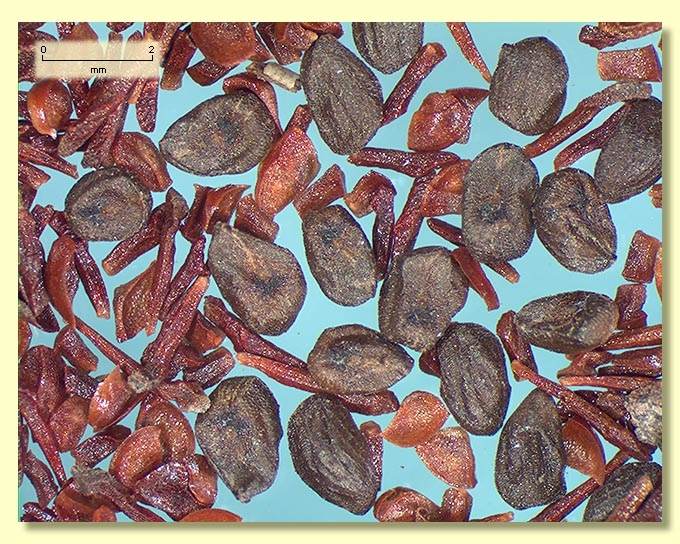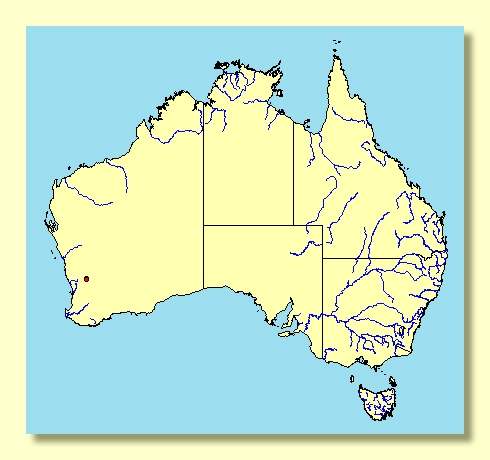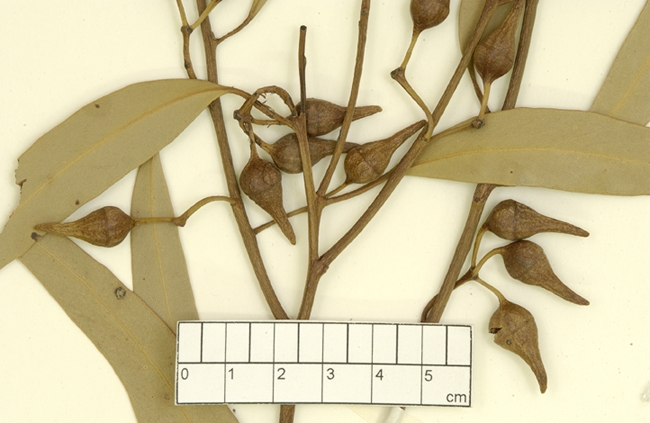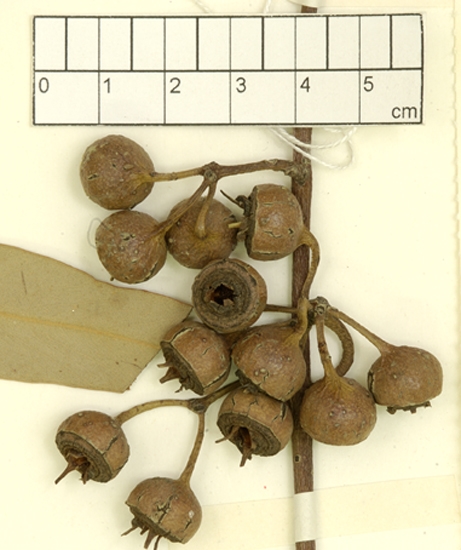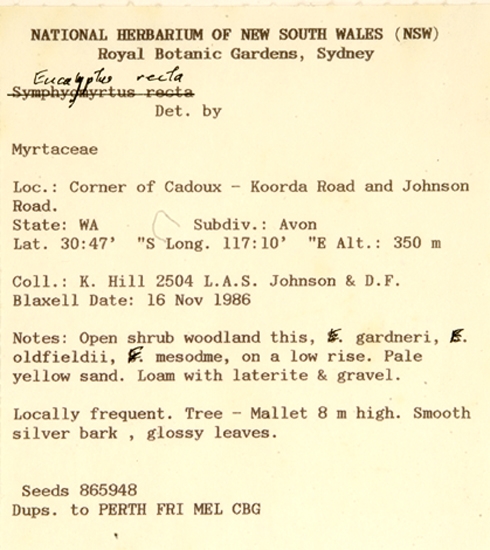Euclid - Online edition
Eucalyptus recta
Eucalyptus | Symphyomyrtus | Bisectae | Destitutae | Falcatae | Rugatae
Bark smooth throughout, mottled silvery grey and pale salmon-pink.
Branchlets lacking oil glands in the pith.
Juvenile growth (coppice or field seedlings to 50 cm): not seen.
Adult leaves alternate, petioles 1–2.4 cm long; blade lanceolate or sometimes falcate, 7–14.5 cm long, 1–2.3 cm wide, base tapering to petiole, margin entire, apex acute, concolorous, glossy, dark green, side-veins acute, reticulation dense to very dense, intramarginal vein very close to margin, oil glands few, intersectional, irregular.
Inflorescence axillary unbranched, pendulous, peduncles 1.5–2.5 cm long, buds 9 or 11, pedicellate (pedicels 0.8–1.3 cm long). Mature buds elongated-ovoid with hypanthium smooth, 1.5–2.5 cm long, 0.6–0.9 cm wide, scar present, operculum narrowly conical, stamens all inflexed or mostly inflexed with a few irregularly flexed, anthers cuboid, versatile, dorsifixed, dehiscing by longitudinal slits, style long and straight, stigma blunt to rounded, locules 3(4), the placentae each with 4 vertical rows of ovules. Flowers creamy white to pale yellow.
Fruit down-turned, pedicellate (pedicels 0.9–1.3 cm long), flattened-globose or less commonly hemispherical, 0.6–0.9 cm long, 1–1.4 cm wide, smooth (un-ribbed), disc descending vertically, valves 3(4), prominently exserted and fragile.
Seeds brown to grey-brown, 1–3 mm long, ovoid or flattened-ovoid, dorsal surface very shallowly reticulate and often with two longitudinal furrows, hilum ventral.
Cultivated seedling: cotyledons Y-shaped (bisected); stems rounded or square in cross-section; leaves subsessile and linear for ca 3 nodes then petiolate, narrowly elliptical until ca node ca 10 then becoming broadly elliptical to ovate, becoming sub-opposite to alternate after node 12, 1.7–3 cm long, 0.7–2.5 cm wide, green, dull.
Flowering has been recorded in January, February and May.
A large mallet endemic to Western Australia, found only in the wheatbelt near Cadoux and nearby on the foothills of the Wongan Hills, in the central wheatbelt. Bark is smooth white to silvery, crown glossy, green, buds pendulous and smooth (un-ribbed), fruit are flattened-globose to hemispherical and smooth, and juvenile growth has petiolate leaves.
Within its restricted natural range Eucalyptus recta is a distintive species and if buds and fruit are present it should not be confused with anything else. Another green leaved seasonally whitish barked tall tree in this area is E. salmonophloia which differs in having non-pendulous and much smaller buds and fruit.
Further to the south-east other similarly smooth-barked mallet species more closely related to Eucalyptus recta occur: E. falcata, found sporadically from Wickepin to Tammin and south to Jerramungup and Lake King, has similar buds but with ribbing on the base, and narrower scarcely ribbed to smooth fruit; E. ornata, restricted to the area immediately around Kondininin, has buds coarsely and sharply ribbed from base of the hypanthium to near the tip of the operculum and fruit with coarse ribs; E. purpurata, restricted to Bandalup Hill area, which has smaller buds slightly ribbed basally and smaller smooth (un-ribbed) fruit; and E. rugulata, found in the Hatter Hill to South Ironcap area east of Varley, and which has buds with pronounced but shallow ribbing on the hypanthium, and shallowly ribbed fruit. The newly described mallet E. annettae differs profoundly in its glaucous branchlets, larger adult leaves, short conical opercukum and ribbed buds and fruit, and is found only near Israelite Bay. Another similar species, the mallee Eucalyptus dorrienii, widespread in wheatbelt and adjacent foothill areas, differs in growth habit and has slightly ribbed buds often shorter than in E. recta, and fruit usually narrower.
In his classification of the eucalypts Brooker (2000) placed E. recta in Eucalyptus subgenus Symphyomyrtus section Bisectae subsection Destitutae because buds have two opercula, cotyledons are Y-shaped and branchlets lack oil glands in the pith. Within this sub-subsection E. recta belongs to a group of mallet and mallee species characterised by often pendulous inflorescences with pedicellate ovoid buds with a conical to beaked operculum, flattened-globose fruits with exserted fragile valves and adult leaves that are green, densely reticulate and have numerous intersectional oil glands and smooth bark. The species are the mallets E. falcata, E. ornata, E. purpurata, E. recta, E. rugulata and the recently described E. annettae; and the mallees E. dorrienii, E. petrensis, E. ecostata and the newly described E. opimiflora, plus the coastal and sub-coastal mallees E. goniantha (with two subspecies), E. kessellii (with two subspecies), E. notactites and E. semiglobosa. These mallets and mallees together form series Falcatae subseries Rugatae, albeit in a form somewhat modified from Brooker's classification.


